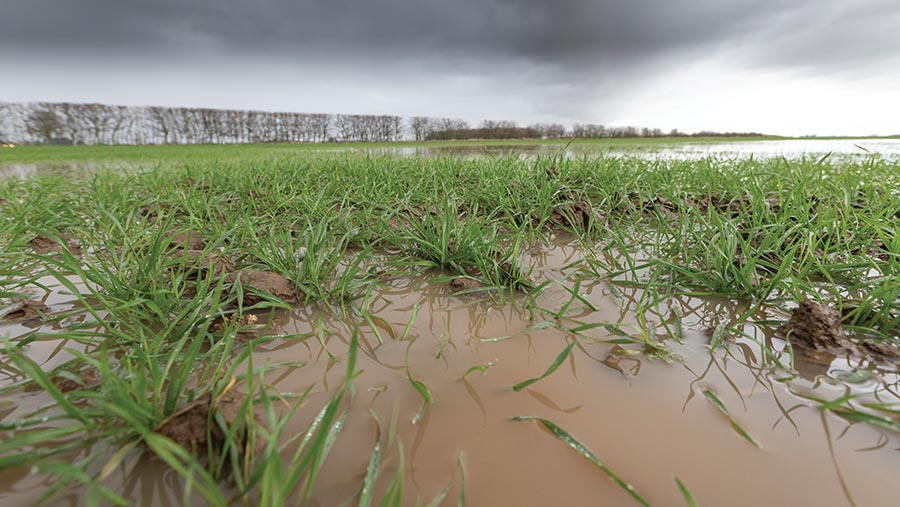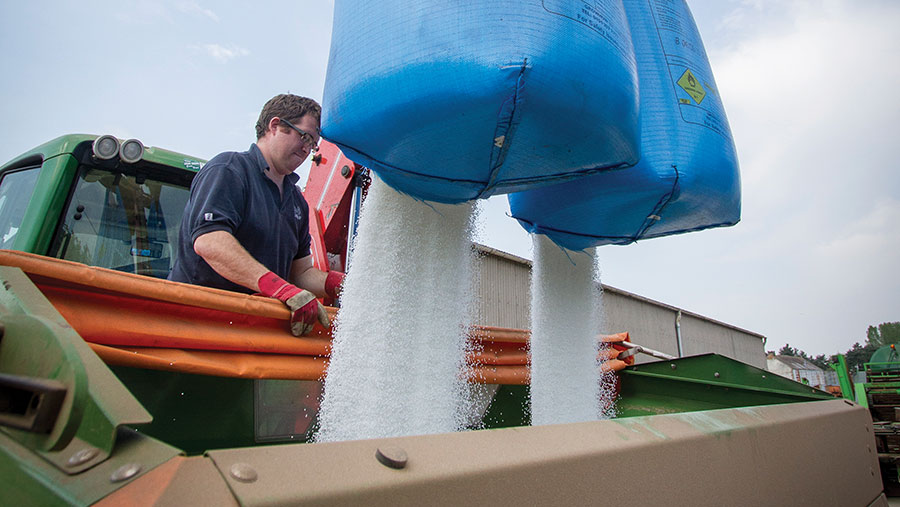Crop Watch: Early crop nutrition key to salvaging backward crops
 © GNP
© GNP One of the wettest winters in living memory has left winter-drilled crops in various states of health ranging from rotted off to OK, depending on soil type and drilling date.
And with large parts still too wet to travel, our agronomists give a regional update from their patch and tease out what farmers can do in the coming weeks, once fields dry out.
See also: 5 steps for managing 2024’s winter wheat disease challenges
South
Tod Hunnisett
AICC (Sussex)
Welcome to 2024. For the past three months I’ve been wandering around looking at stuff, wondering exactly why I’ve been doing it.
If I’ve found anything that needs attention, there has been very little anyone can do about it anyway.
Winter-sown crops are in various stages of health. Fields that went in and came up before the weather broke generally look in pretty good nick.
In fact, if the mild winter continues, they’re looking a bit too healthy for their own good.
Crops that went into anything but chalk just before the rain started don’t look so special.
Those that were drilled in the little pre- and post-Christmas windows we had (which out of pure practicality would have gone into kinder land) actually look surprisingly well.
Lawn test
I have a very scientific growth monitoring system I have used for many years. It’s called my lawn. At present, it looks like it would if it hadn’t been mowed for a month in May.
So stuff has been growing pretty much non-stop over the winter.
The only things that haven’t are where they’ve been waterlogged, especially oilseed rape, that has gone backwards in areas that should have been deep cultivated last autumn.
Whoever came up with this crazy idea that good farming involves not moving soil needs to spend some time going round various bits of the South of England.
Interestingly, there is now more evidence emerging that the soil’s ability for microbial decomposition becomes saturated if not enough of it is moved. I thought that was discovered about 40,000 years ago.
Before long the season will wake up. Struggling crops will need a nutritional helping hand, such as nitrogen. Lush crops definitely won’t.
But it’s worth remembering that nitrogen only feeds growth, it doesn’t promote it, and spreading fertiliser onto waterlogged land is much the same as tipping it into a river.
And it won’t be long before we all realise that there aren’t enough hours in a day.
East
Marion Self
AICC/Prime Agriculture (Suffolk)
It has been a long and difficult, wet, warm winter and we are all well aware there’s a lot to do when field conditions allow.
Wheat crops are falling into three main categories. First are those drilled in September which have come through the winter relatively well with promising yield potential.
These largely have received the intended pre-emergence herbicide, barley yellow dwarf virus (BYDV) and manganese sprays.
Second are the more miserable-looking wheats which were drilled close to the first heavy rain in mid-October and are somewhat beleaguered or, at best, “OK-ish”.
Varying sized bare areas abound where the combination of wet and poor soil structure has killed out the crop. Some of these received a herbicide and some didn’t.
Third are the later December/January drilled crops that have emerged well and are fighting. But these are smaller and likely not to have received a herbicide yet.
All crops will need to be categorised and managed according to their expected yield potential, required inputs and likely threats.
Where outstanding, BYDV and manganese applications should be completed as soon as you are able – it’s been mild. All winter cereal crops are hungry; heavy rainfall and warm conditions have caused significant nutrient losses.
Managing early crop nutrition and canopies will be key to maximising yield potential this spring.
This has already been illustrated by the dramatic crop responses to nitrogen applied during a few drier days at the beginning of February.
Consequently, attention to crop nutrition (macro- and micronutrients) is a priority this spring and as soils begin to dry, these applications will help crop recovery, also allowing safer application of herbicides as required.
Grassweed strategy
For wheat, the appropriate grassweed strategy will depend on the field history and weeds present, but more particularly this season, how long ago the crop was drilled.
It may still be appropriate to apply a residual based treatment where crops and weeds are just emerging.
However, where crops and weeds are well established a contact with or without a residual partner will be required.
We hope these will work on relatively small weeds, but control may be disappointing if grassweeds are already well tillered and established.
Warm, wet conditions are also encouraging disease development, with mildew and rust easily found in susceptible cereal varieties, particularly yellow rust in late emerging crops.
In most cases disease control can be deferred until the T0 timing (early stem extension), but crops should be monitored and treated before if required.
Despite the wet conditions, most rapeseed crops look well and are beginning stem extension. These urgently need nutrition followed by appropriate plant growth regulation at green to early yellow bud.
Winter bean crops are more variable depending on the time and method of drilling. Some earlier drilled crops are thriving, whereas later ones ploughed in difficult conditions have emerged slowly and are thinner.
Unfortunately, some of these crops did not receive the planned pre-emergence herbicides and consequently weed control could be problematic, with limited post-emergence choices available.
Many growers are concerned about how they will manage to establish spring crops in wet, damaged soils. Some fields will likely be left uncropped or put into environmental schemes.
However, for most there is still plenty of time to sow, but for now it’s a waiting game as soils dry out, the speed of which will depend on soil type and its general condition.
West
Antony Wade
Hillhampton Technical Services (Hereford/Shropshire)
Well, this season just keeps on giving, but not in a good way. While we haven’t had a named storm recently, every 10mm rain event with saturated soils results in those unwanted ponds of water appearing in fields again.
For the past five months we seem to get two to three days without rain when we get excited and start to think about catching up on outstanding fieldwork jobs, only for hopes to be dashed by another rain event.
Never have I drafted so many recommendations only to have to revise them again and again.
I don’t think I have ever had so much wheat which hasn’t had any herbicide. This will now be contact chemistry, although some January drilled wheat residual herbicides may still be appropriate.
February is often a good month to deploy contact chemistry, but with more than 100mm of rain so far and nothing sprayed with a few days of the month left, we can only pray March is drier.
Almost more worrying is unsprayed winter barley as we have more limited contact grassweed options in this crop as with other minor cereals.
We will have to try to thicken up these crops to try to smother grassweeds as much as possible.
To do this, they will require some foliar trace elements, including manganese at the earliest opportunity, plus some nitrogen and sulphur as soon as we can travel with fertiliser spinners.
Barley diseases
The incessant rain has meant rhynchosporium is easily found and mildew has enjoyed the mild and damp conditions we have had for most of February.
As maximising tiller numbers is critical for optimum performance in barley, a T0 fungicide can be more beneficial than in many other crops, combined with some plant growth regulator to ensure and promote tiller survival.
Oilseed rape has started to move into stem extension after a week of temperatures in double digits.
This is slightly disconcerting for those crops where weed control is still required, as the 1 March start date will not be soon enough for some crops.
Canopies are hugely variable in most crops, either due to establishment difficulties, wet areas suffering, pigeon grazing, or all of the above.
As soon as ground conditions dry up these crops will have to be a priority for first fertiliser applications.
I can fully understand why growers are considering Sustainable Farming Incentive options as guaranteed income although they won’t fully replace the reducing Basic Payment Scheme.
North
Conor Campbell
Hutchinsons (Northumberland)

© GNP
This is certainly a challenging start to the Crop Watch season, as the weather teases us with some sunshine, then decides to turn the sprinkler system on again.
I acknowledge that the current weather and crop conditions are extremely challenging and frustrating.
It would be all too easy for me to complain about the weather; instead I’m going to discuss some of the things we can control.
Rooting was a major issue last spring and resulted in a large amount of lodging.
Crops that sit in waterlogged soils will shed their roots as a survival mechanism. Early nutrition will be key to encouraging new root growth and anchoring crops into the soil.
Nitrogen is important, but primarily encourages biomass production and high doses will cause crops to concentrate on the main stem, unless we can use proper plant growth regulation.
Phosphate will promote root growth, be this bagged, foliar or, if you are happy to invest, phosphites which encourage the most root growth.
Root focus
Give crops a chance. If we overly restrict the inputs to a crop then we have decided its fate already.
There are some good crops out there, with reasonable yield potential, but some of the poorer looking fields could still be surprising if they are afforded the opportunity.
Start with a low rate of nutrition and PGR to encourage tillering.
Be careful with early herbicide applications, particularly acetolactate synthase (ALS) inhibiting chemistry on wheat, until they are actively growing and look healthy.
The last thing we want to do is set a backward crop back even more.
Good old-fashioned rolling might be a benefit when ground conditions improve. This will not only encourage rooting, but allow air back into the soils.
Soils are currently anaerobic due to the waterlogging. This means the vital soil biology cannot function as we need it to, so letting these soils breathe again will be a huge help.

